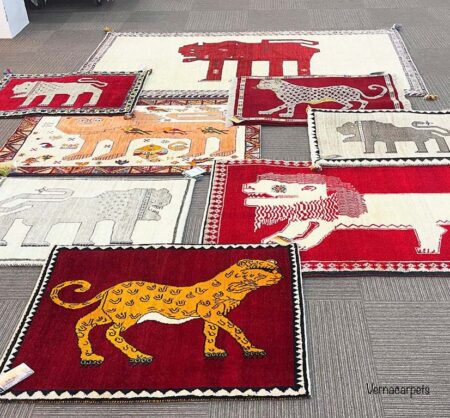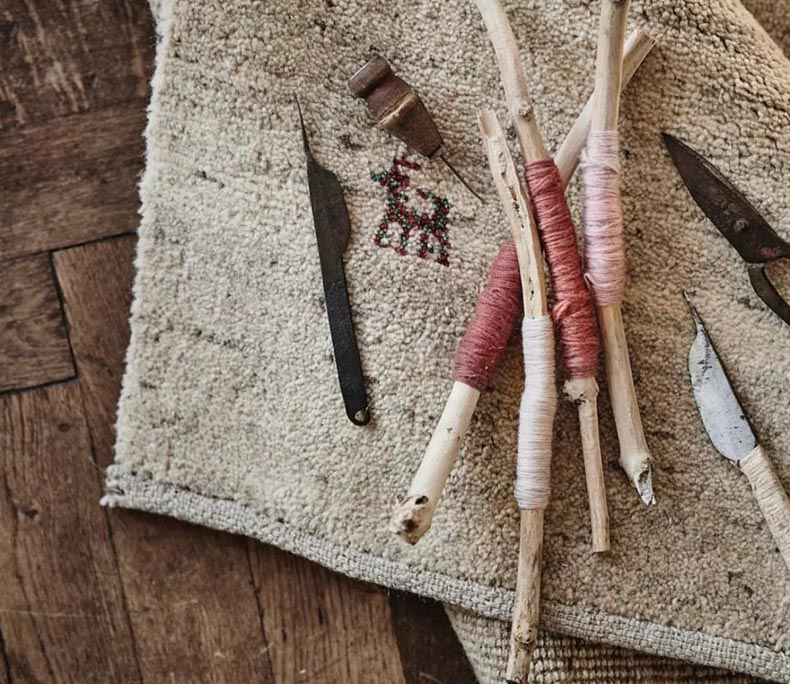What is Gabbeh?
Gabbeh is one of the rugs that is usually woven in small size by Bakhtiari and Qashqai nomads of Iran. Fars province is one of the pioneers of this art in the field of weaving gabbeh, which is more than 150 years old. We can confidently say that the gabbehs of the Qashqai nomads are among the best, so that they are highly respected abroad. The gabbehs that were woven in the past were self-coloured. That is, they used sheep’s wool with its natural colour and without colour change, and included only black, white, and gray colours. Over time, weavers used vegetable and natural dyes for wool. Today, chemical dyes are also used to dye the wool of gabbehs.


A Collection of Hand-Woven Gabbehs
The history of Gabbeh
If we were going to talk about the oldest carpet in the world, we could introduce the Pazyrik carpet as the oldest carpet based on the discoveries and historical traditions, but there is no reliable source about the oldest gabbeh, for this reason, we cannot definitely determine the date of gabbeh. But we can definitely say that gabbehs were produced when humans managed to use animal wool as a mattress. Gabbeh is also known as nomadic carpet because it was first produced by Iranian nomads. Gabbeh means thick and rough in the dictionary, but the origin of this word goes back to the time of Shah Tahmasb.
You can see: What Do You Know about the World’s First Carpet, Pazyryk?


Beautiful Persian Qashqai Gabbeh
What are the characteristics of Gabbeh?
- Gabbeh is woven mentally and without a plan.
- High-quality gabbeh has a relatively high price.
- Gabbeh has long piles and the pile height is about one cm.
- It has a coarse texture and not much delicacy can be seen in it.
- Gabbeh is woven in small and medium sizes between 2 and 6 square meters.
- Gabbeh is soft because of the long piles and give more warmth to the house.
- The type of knot that is used to weave the gabe are mostly asymmetric knots.
- Due to having long piles and higher density, the gabbehs are very comfortable and soft.
- More number of wefts (3 to 5) are used in the weaving of gabbeh, which makes it softer.
- Gabbeh is very durable and the high-quality type maintains its attractiveness for several years.
- Due to the long piles, the gabbeh have more weight. On average, the weight of each square meter is 3 kg.


Gabbeh Cushion Cover
What is the difference between gabbeh and hand-woven carpet?
- Hand-woven carpet has three dimensions: length or warp, width or weft, and height, which is the pile of the rug. Like a carpet, it has warp, weft, and pile. But the pile of the gabbeh is longer than the pile of the carpet. Also, the number of wefts used in the gabbeh is more than that of the carpet.
- The fibers used in gabbeh are usually sheep wool mixed with goat hair. While in handwoven carpets, in addition to wool, cotton, fluff and silk are also used.


Beauty, Comfort, This Is the Gabbeh Rug Promise!
- The looms used to weave gabbeh are mostly horizontal, because this hand-crafted is woven by nomads, and because of their lifestyle, nomads use horizontal looms. But the looms used to weave carpets are mostly vertical looms, except for nomadic carpets. which are used to weave them using horizontal looms.
- Handwoven carpets are woven in various dimensions, the three sizes of 6, 9 and 12 square meters are very common. But gabbeh is woven in dimensions smaller than 6 square meters.
- Both carpets and gabbehs have piles, but gabbehs are heavier than carpets per square meter due to the long piles.
- Handwoven carpet is woven according to a specific plan, but gabbeh is woven mentally, that’s why weaving of carpet takes more time than weaving of gabbeh.
What is the difference between a gabbeh and a kilim?
- Gabbeh is much heavier than kilim due to its pile.
- Gabbeh is softer and warmer than the kilim due to its piles.
- The material used in the kilim is wool and cotton, while wool is used for the gabbehs.
- The kilim is woven without pile and only has warp and weft. But the gabbeh also has pile.
- The colours used in the kilim are more varied than the colours of the gabbeh.
- The dimensions of the kilim are usually bigger than the gabbeh, but generally the rug is woven under 6 square meters.
- In the kilim , we only have the structure of warp and weft and the weft only passes between the warps, but in the gabbeh we have 3-dimension: warp, weft and pile.


Hand-Knotted Beauty with Minimalistic Gabbeh
The designs of gabbeh
Gabbeh weaving is more common among nomads, and one of the most beautiful features of nomadic carpets is the abstractness of its designs. They weave gebbeh mentally and without a plan. Weavers get inspiration from their surroundings and weave their favourite designs and dreams on the looms. The most important design that is woven among the nomads is the lion motif, which is very popular among the weavers. Other famous designs include: Kheshti, rose, tree, stripes, animals, and simple-background. Each of these designs has a meaning. For example, the cypress tree is a symbol of happiness and freedom, and the willow tree is a symbol of sadness.


Lion Design Gabbeh in Japan
Principles of gabbeh care
The gabbeh is woven from wool fibers, so they are vulnerable to willows. The long wool piles make the gabbehs strong and durable. To the extent that the production stages of gabbeh are important, its maintenance is also very important. Factors that damage gabbeh include insects such as willows, cockroaches, and mice, among which, willow is the worst. It is recommended to use naphthalene and tobacco to deal with willow-eating. In addition to the above explanations, follow the following points to increase the lifespan of the gabbeh:
- Sweep the gabbe regularly on a weekly basis.
- Avoid spreading gabbeh on limestone and plaster floors.
- Avoid washing the gabbeh with strong detergents and stain removers.
- If you need to wash, be sure to contact a carpet cleaner.
- Avoid placing the gabbeh in a dark and humid environment.
- Do not spread the gabbeh in front of the sunlight for a long time.


Striped- Design Gabbeh
Tips for buying gabbeh
Due to its traditional atmosphere, natural colour scheme and minimal designs, Gabbeh gives fresh and positive energy to the arrangement, and because of this characteristic, Gabbeh has become one of the most popular items as a floor covering. We can use traditional patterned gabbehs to create a unified decoration alongside the modern arrangement. One of the important points when buying a gabbeh is to pay attention to its dyeing. In order to be able to distinguish the natural colour of the fibers from the chemical dye, note that the chemical dye is very bright and does not have the maturity of the natural colour. Secondly, when shopping, take a piece of wet white cloth with you and draw it on the colour you want. If it takes the colour of the gabbeh, it means that the colour is not good. In this article, we tried to tell you all the points related to gabbeh, if you have any experience of using gabbeh or have any questions, please let us know in the comments section.

















2 thoughts on “What Is Gabbeh? Everything You Need to Know about Gabbeh!”